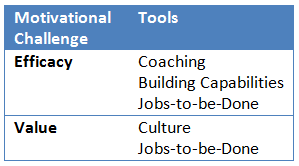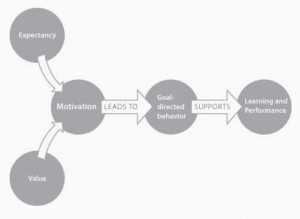Motivating students is hard. Surveyed teachers recently ranked motivation as their number one biggest struggle with students. Fortunately, good theory can make it easier.
In a recent blog I discussed a theory that helps us make sense of motivation. In brief, that theory states that a person’s motivation to achieve a goal has two distinct and critical components: the importance that a person places on the goal (value) and the degree to which the person believes he is capable of achieving that goal (expectancy).
From How Learning Works: Seven Research-Based Principles for Smart Teacher
A guide for figuring out motivation
It is important to note that this theory does not tell us what will motivate students. It does, however, help us determine where to focus our efforts. To start, we first need ask if our goals and activities are demotivating because students do not value them or because students lack a sense of efficacy.
Efficacy
If low efficacy is the issue, then we next need to assess whether or not students are actually capable of doing what we ask of them. If students are capable, then they probably just need to be coached through a few steps or examples to help them recognize their capabilities and develop a sense of efficacy. Part of this coaching might also include helping them re-evaluate their internal explanations for their past successes and failures.
On the other hand, if efficacy is missing due to a true lack of capabilities, we need to back track in our instruction in order to meet students at the frontier of their existing capabilities. Cheerleading, “you can do it,” won’t help if students are not yet capable. A sense of efficacy comes from experiencing success, not just from thinking positively. If you temporarily boost efficacy with positive encouragement only to set students up for failure, you will ultimately undermine their sense of efficacy—along with your credibility. When efficacy is missing due to a lack of capability, we need to scaffold our instruction so that it raises students’ capabilities from where they are currently at to the where we want them to be.
A major challenge to addressing the capability side of the equation is that capabilities differ between students. In any given classroom there are students who quickly excel at a given task, whereas there are others who perpetually seem to struggle. Mastery-based learning offers a great solution to this problem. It ensures that students only progress to new learning challenges once they have developed the prerequisite capabilities. Blended learning is the tool that makes this kind of individualized and adaptive instruction possible. As Michael B. Horn has pointed out, this is why competency-based learning can be intrinsically motivating.
Value
If student motivation is failing because students do not value the goals and activities we give them, the solution requires very different strategies. The common mindset for addressing this side of the equation is to get students to change what they value. Unfortunately, getting students to change what they value is easier said than done. Countless teachers have thrown up their hands in the face of motivational roadblocks after coming to the conclusion that some students just don’t care.
Unfortunately, instruction is not an effective tool for getting students to change what they value. Just telling students that something should be important to them rarely alters their inner mindsets and beliefs. In reality, students come to value something when they see consistent and convincing evidence that it leads to what they innately desire.
In part two of this blog I will discuss strategies for targeting the value side of motivation. I will also highlight how the Jobs-to-be-Done theory can be used to address both efficacy and value.




